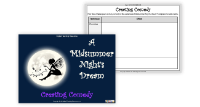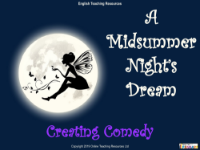A Midsummer Nights Dream Lesson 11: Creating Comedy - Worksheet

English Resource Description
In Lesson 11 of an English curriculum focused on Shakespeare's "A Midsummer Night's Dream," students delve into the comedic aspects of the play. The lesson's central activity involves a worksheet where students are tasked with examining how Shakespeare creates humour and conveys it to his audience. The worksheet is structured as a table with two columns: 'Technique' and 'Effect'. Students are required to consider different elements of the play, such as 'Characters', 'Events', 'Language', and 'Stagecraft', and analyse how each contributes to the overall comedic effect.
The exploration of 'Characters' could involve looking at the traits and interactions of figures like the mischievous Puck or the bumbling 'Mechanicals' and how they generate laughter. Under 'Events', students might investigate the series of enchanting and absurd situations, such as the love potion mix-ups. 'Language' invites an examination of Shakespeare's wordplay, puns, and clever dialogue that elicit humour. Finally, 'Stagecraft' encompasses the physical elements of performance, including timing, movement, and visual gags, which play a significant role in creating comedic moments. Through this activity, students gain a deeper appreciation of Shakespeare's skill in weaving comedy into his works and the various techniques that make "A Midsummer Night's Dream" a timeless and entertaining play.


